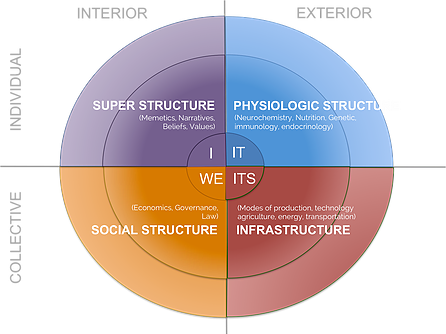Design Criteria

Inspired by Ken Wilbur’s Integral Theory, the think tank called The Emergence Project created the above model.
The four quadrants represent these four metastructures:
- Memetic Structure (I = individual subjective): Human Values, Beliefs, Meaning, Orienting Stories and Narratives, Worldview, Identity, Definition of success
- Physiologic Structure (IT = individual objective): Behavioral Influencers — Nutrition, Neurochemistry / Neurobiology, Endocrinology, Epigenetics, Toxicity, Nutrition
- Social Structure (WE = collective intersubjective): Economics, Governance, Law
- Infrastructure (ITS = collective interobjective): Modes of production: Energy, Agriculture, Transportation, Energy Generation, Water, Building Technology, Waste Management
All factors that condition human behavior live in these quadrants. Each of the quadrants is fundamental and irreducible with respect to the others, so these categories are both necessary and sufficient for inventorying all sources of human conditioning.
The metastructures co-evolve and co-influence each other in complex ways, and must all be factored together to effectively evolve society. Most social philosophies have emphasized one of these areas as fundamental, leading to projects focused in that area to the exclusion of the others. Such a reductionist orientation is simply inadequate for systems as complex and interconnected as human society and the biosphere.
Below are examples of metastructure shifts, by category. Note that these do not include all design criteria.
Memetic Structure
| From | To |
|---|---|
| Separate Parts | Interconnected Wholes |
| False Dichotomies | Meaningfully Reconciled Paradox |
| Competition | Collaboration |
| Random Universe | Emergent Universe |
| Unifying Through Homogeny | Unifying Across Diversity |
| Self-centered or Self-sacrificing | Omni-considerate |
Social Structure - Economics
| From | To |
|---|---|
| Win-lose structures | Win-Win structures |
| Growth | Post Growth & Evolving Homeostasis |
| Separate Ownership | Resource Optimizing Commonwealth |
| Transactional Accounting | Systemic Accounting |
| Possession | Access |
| Extrinsic Motive | Intrinsic Motive |
| Competition as Driver | Conscious Evolution as Attractor |
| Profit / Resource Extraction | Resource Circulation |
| Extraction & Production Cost Accounting | Life Cycle Cost Accounting |
| Scarcity Valuation | Utility Valuation |
| Competing Metrics | Comensurated Metrics |
Social Structure - Governance
| From | To |
|---|---|
| Imposed (Command & Control) | Emergent (Self-Governance) |
| Person Mediated | Process Mediated |
| Conflicting Values | Inclusive Holarchy of Values |
| Imperialistic vs. Anarchistic | Consciously Self-regulating |
| Implicit Outcomes | Explicit Outcomes |
| Symptomatic | Cause |
| Uncoordinated Partial Solutions | Systems Solutions |
| Opinion Based | Data Based |
| Arbitrary Purview | Governance at the Level of Effect Law |
| Punitive | Protective & Rehabilitating |
| Interventionary | Preventative |
Infrastructure
| From | To |
|---|---|
| Centralized | Decentralized & Distributed |
| Linear Materials Economy | Closed Loop Materials Economy |
| Depleting & Extractionary | Regenerative |
| Fixed | Modular & Adaptive |
| Goods | Services |
| Possession & Ownership | Access & Sharing Structures |
| Nature & Technology Divide | Biomimicry |
| Commodity Based | Technology Based |
| Labor Work Force | Automation |
Subscribe to Our Newsletter
Stay in the loop with exclusive updates – Subscribe to our newsletter today!
